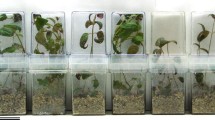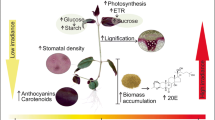Abstract
The present study aimed to verify the effects of induced polyploidization on Pfaffia glomerata regarding its 20-hydroxyecdysone (20E) production both in vitro and under greenhouse conditions, its in vitro photoautotrophic potential, and its ex vitro biomass accumulation and photosynthetic performance. Synthetic polyploidization efficiently produced individuals with increased in vitro photoautotrophic potential and ex vitro biomass accumulation, although photosynthetic rates per leaf area did not vary between diploids and tetraploids. Among the five tetraploids tested (P28, P60, P68, P74, and P75), P28 showed significantly increased biomass both in vitro and ex vitro when compared with diploid plants, whereas the other tetraploids did not differ significantly from the diploids in terms of biomass accumulation. Although photosynthetic rates per unit leaf area remained constant among all the plants tested, P28 showed a significantly greater total leaf area, which may have resulted in an increase in net photosynthesis on a whole-plant basis. Under greenhouse conditions, the 20E content in the tetraploid P28 was 31% higher than that in diploid plants, and the final 20E mass per plant produced by P28 ex vitro was approximately twice that produced by diploid plants. Accumulation of 20E in vitro did not follow the same pattern observed among the plants ex vitro; instead, greater accumulation was observed in diploid plants. The induction of polyploidy in P. glomerata appears to be a promising strategy for producing plants with higher biomass accumulation and 20E production ex vitro, in addition to its higher in vitro photoautotrophic potential.









Similar content being viewed by others
References
Aguiar TV, Sant’anna-Santos BF, Azevedo AA, Santos RF (2007) Anati Quanti: Software de análises quantitativas para estudos em Anatomia Vegetal. Planta Daninha 25:649–659
Bennett RN, Wallsgrove RM (1994) Secondary metabolites in plant defense mechanisms. New Phytol 127:617–633
Borgaud F, Gravot A, Milesi S, Gontier E (2001) Production of plant secondary metabolites: a historical perspective. Plant Sci 161:839–851
Carulo MF (2012) Use of SFC in extraction of adaptogens from Brazilian plants. Am J Analyt Chem 3:977–982
Caruso I, Dal Piaz F, Malafronte N, De Tommasi N, Aversano R, Zottele CW, Scarano MT, Carputo D (2013) Impact of ploidy change on secondary metabolites and photochemical efficiency in Solanum bulbocastanum. Nat Prod Commun 8:1387–1392
Corrêa JPO, Vital CE, Pinheiro MVM, Batista DS, Azevedo JFL, Saldanha CW, Cruz ACF, DaMatta FM, Otoni WC (2015) In vitro photoautotrophic potential and ex vitro photosynthetic competence of Pfaffia glomerata (Spreng.) Pedersen accessions. Plant Cell Tiss Organ Cult 121:289–300
Dalvi VC, Meira RMSA, Azevedo AA (2013) Extrafloral nectaries in neotropical Gentianaceae: occurrence, distribution patterns, and anatomical characterization. Am J Bot 100:1779–1789
Dehghan E, Häkkinen ST, Oksman-Caldentey KM, Shahriari Ahmadi F (2012) Production of tropane alkaloids in diploid and tetraploid plants and in vitro hairy root cultures of Egyptian henbane (Hyoscyamus muticus L.). Plant Cell Tiss Organ Cult 110:35–44
Dhawan OP, Lavania UC (1996) Enhancing the productivity of secondary metabolites via induced polyploidy: a review. Euphytica 87:81–89
Ferreira DF (2003) Sisvar 5.0. Available online: http://www.dex.ufla.br/~danielff/programas/sisvar.html
Gao SL, Zhu DN, Cai ZH, Xu DR (1996) Autotetraploid plants from colchicine treated bud culture of Salvia miltiorrhiza Bge. Plant Cell Tiss Organ Cult 47:73–77
Gomes SSL, Saldanha CW, Neves CS, Trevizani M, Raposo NRB, Notini MM, Santos MO, Campos JMS, Otoni WC, Viccini LF (2014) Karyotype, genome size, and in vitro chromosome doubling of Pfaffia glomerata (Spreng.) Pedersen. Plant Cell Tiss Organ Cult 118:45–56
Iarema L, Cruz ACF, Saldanha CW, Dias LLC, Vieira RF, Oliveira EJ, Otoni WC (2012) Photoautotrophic propagation of Brazilian ginseng [Pfaffia glomerata (Spreng.) Pedersen]. Plant Cell Tiss Organ Cult 110:227–238
Kim YS, Hahn EJ, Murthy HN, Paek KY (2004) Effect of polyploidy induction on biomass and ginsenoside accumulations in adventitious roots of ginseng. J Plant Biol 4:356–360
Lafont R, Dinan L (2003) Practical uses for ecdysteroids in mammals including humans: an update. J Insect Sci 3:1–30
Lavania UC (2005) Genomic and ploidy manipulation for enhanced production of phyto-pharmaceuticals. Plant Genet Res 3:170–177
Lorenzi H, Matos FJA (2002) Plantas Medicinais do Brasil: Nativas e exóticas cultivadas. Instituto Plantarum, Nova Odessa, SP, Brazil
Martelotto LG, Ortiz JPA, Stein J, Espinoza F, Quarin CL, Pessino SC (2007) Genome rearrangements derived from autopolyploidization in Paspalum sp. Plant Sci 172:970–977
Mecchia MA, Ochogavia A, Selva JP, Laspina N, Felitti S, Martelotto LG, Spangenberg G, Echenique V, Pessino SC (2007) Genome polymorphisms and gene differential expression in a ‘back-and-forth’ ploidy altered series of weeping lovegrass (Eragrostis curvula). J Plant Physiol 164:1051–1061
Molin WT, Meyers SP, Baer GR, Schrader LE (1982) Ploidy effects of isogenic populations of alfalfa: II. Photosynthesis, chloroplast number, ribulose-1,5-bisphosphate carboxylase, chlorophyll, and DNA in protoplasts. Plant Physiol 70:1710–1714
Murashige T, Skoog F (1962) A revised medium for rapid growth and bio-assays with tobacco tissue cultures. Physiol Plant 15:473–497
Nascimento EX, Mota JH, Vieira MC, Zárate NAH (2007) Produção de biomassa de Pfaffia glomerata (Spreng.) Pedersen e Plantago major L. em cultivo solteiro e consorciado. Ciência Agrotecnol 31:724–730
Osborn TC, Chris-Pires J, Birchler JA, Auger DL, Chen ZF, Lee H, Comai L, Madlung A, Doerge RW, Colot V, Martienssen RA (2003) Understanding mechanisms of novel gene expression in polyploids. Trends Genet 19:141–147
Ozkan H, Levy AA, Feldman M (2001) Allopolyploidy-induced rapid genome evolution in the wheat (Aegilops–Triticum) group. Plant Cell 13:1735–1747
Saldanha CW, Otoni CG, Azevedo JLF, Dias LLC, Rêgo MM, Otoni WC (2012) A low-cost alternative membrane system that promotes growth in nodal cultures of Brazilian ginseng [Pfaffia glomerata (Spreng.) Pedersen]. Plant Cell Tiss Organ Cult 110:413–422
Saldanha CW, Otoni CG, Notini MM, Kuki KN, Cruz ACF, Neto AR, Dias LLC, Otoni WC (2013) A CO2-enriched atmosphere improves in vitro growth of Brazilian ginseng [Pfaffia glomerata (Spreng.) Pedersen]. In Vitro Cell Dev Biol Plant 49:433–444
Saldanha CW, Otoni CG, Rocha DI, Cavatte PC, Detmann KSC, Tanaka FAO, Dias LLC, DaMatta FM, Otoni WC (2014) CO2-enriched atmosphere and supporting material impact the growth, morphophysiology and ultrastructure of in vitro Brazilian-ginseng [Pfaffia glomerata (Spreng.) Pedersen] plantlets. Plant Cell Tiss Organ Cult 118:87–99
Vigo CLS, Narita E, Marques LC (2003) Validação da metodologia de quantificação espectrofotométrica das saponinas de Pfaffia glomerata (Spreng.) Pedersen—Amaranthaceae. Rev Bras Farmacogn 13:46–49
Vigo CLS, Narita E, Milaneze-Gutierre MA, Marques LC (2004) Caracterização farmacognóstica comparativa de Pfaffia glomerata (Spreng.) Pedersen Hebanthe paniculata Martius—Amaranthaceae. Rev Bras Plant Med 6:7–19
Warner DA, Edwards GE (1988) C4 photosynthesis and leaf anatomy in diploid and autotetraploid Pennisetum americanum (pearl millet). Plant Sci 56:85–92
Warner DA, Edwards GE (1989) Effects of polyploidy on photosynthetic rates, photosynthetic enzymes, contents of DNA, chlorophyll, and sizes and numbers of photosynthetic cells in the C4 dicot Atriplex confertifolia. Plant Physiol 91:1143–1151
Warner DA, Edwards GE (1993) Effects of polyploidy on photosynthesis. Photosynth Res 35:135–147
Xu CG, Tang TX, Chen R, Liang CH, Liu XY, Wu CL, Yang YS, Yang DP, Wu H (2014) A comparative study of bioactive secondary metabolite production in diploid and tetraploid Echinacea purpurea (L.) Moench. Plant Cell Tiss Organ Cult 116:323–332
Acknowledgments
The authors thank the National Council for Scientific and Technological Development (CNPq) [MCT 480675/2009-0; PDJ 500874/2012-3; PQ 303201/2010-10, and MCTI 459529/2014-5 to WCO], the Minas Gerais State Research Foundation (FAPEMIG) [CAG-APQ-01036-09; CRA-APQ-01651-13; CRA-BPD-00046-14], and CAPES (PNPD) for financial support. We also thank Dr. Roberto Vieira and Dr. Rosa das Neves Alves (National Center for Genetic Resources and Biotechnology—Embrapa/Cenargen, Brasília, DF, Brazil) for providing Pfaffia glomerata accessions.
Author information
Authors and Affiliations
Corresponding author
Ethics declarations
Conflicts of Interest
The authors declare that there are no conflicts of interest.
Authors’ Contributions
JPOC, CEV, DMSF, MMN, MVMP, DSB, CWS, and ACFC performed the experiments. JPOC and ACFC raised the in vitro plants for the experiments. JPOC, FMD, and WCO contributed to the design and interpretation of the research and to the writing of the paper.
Additional information
Editor: David Duncan
Rights and permissions
About this article
Cite this article
Corrêa, J.P.O., Vital, C.E., Pinheiro, M.V.M. et al. Induced polyploidization increases 20-hydroxyecdysone content, in vitro photoautotrophic growth, and ex vitro biomass accumulation in Pfaffia glomerata (Spreng.) Pedersen. In Vitro Cell.Dev.Biol.-Plant 52, 45–55 (2016). https://doi.org/10.1007/s11627-016-9746-9
Received:
Accepted:
Published:
Issue Date:
DOI: https://doi.org/10.1007/s11627-016-9746-9




